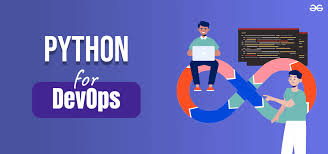Day 15: Diving Deeper into Python for DevOps
 Gunjan Bhadade
Gunjan Bhadade
As a DevOps engineer, mastering Python can significantly enhance your ability to automate tasks and manage infrastructure efficiently. Python is a versatile, easy-to-learn programming language that's widely used in the DevOps ecosystem for scripting, automation, and building applications.
🐍 What's Python All About?
Python is like a Swiss Army knife for programmers. It's open source, high-level, and object-oriented – a true gem created by the brilliant Guido van Rossum. 🙌 With its clean and readable syntax, Python simplifies the coding process, making it a great choice for both beginners and experts.
One of Python's most captivating features is its extensive library ecosystem. 📚 From web development (Django and Flask) to machine learning (TensorFlow and Keras), there's a library or framework for nearly every imaginable application. It's like having a toolbox with tools for every task!
🚀 Let's Get Started: Installation Made Easy
Worry not, installing Python is as simple as sending a text! 😄 Regardless of whether you're using Windows, macOS, Ubuntu, CentOS, or any other system, Python has got your back. Here's how you can do it:
For Windows: Visit the Python official website, download the installer, and follow the prompts.
For Ubuntu: Open up your terminal and type:
Now you're ready to roll!
sudo apt-get install python3.6
🔥 Your Task: Install Python on your preferred operating system and don't forget to check out your newly installed Python's version. 🕵️♂️
🎯 Dive into Data Types:
Alright, let's talk data! 📊 Python comes with some pretty nifty data types that you'll be using to build your programming marvels. Here's a sneak peek:
Integers (
int): Whole numbers without a decimal point. Think of them as the building blocks of math in programming.Floating-Point Numbers (
float): Numbers with decimals – perfect for calculations requiring precision.Strings (
str): Textual data enclosed in single or double quotes. They're like the characters in your code's story.Lists (
list): Ordered collections of items. It's like a digital shopping list for your code.Tuples (
tuple): Similar to lists but immutable. Once you set it, it's like a wax seal on a secret scroll – it won't change.Dictionaries (
dict): Key-value pairs, like a real dictionary where words (keys) have meanings (values).Sets (
set): Unordered collections of unique items. Think of it as a bag where you don't repeat items.
Differences between List, Tuple, and Set:
List:
Mutable: You can modify the elements after creation.
Ordered: Elements are stored in the order they are added.
Allows duplicate elements.
Created using square brackets
[].Example:

Tuple:
Immutable: Once created, elements cannot be changed.
Ordered: Similar to lists, elements are stored in order.
Allows duplicate elements.
Created using parentheses
().Example:

Set:
Mutable: Elements can be added or removed after creation.
Unordered: Elements are not stored in a specific order.
Does not allow duplicate elements.
Created using curly braces
{}or by using theset()constructor.Example:

Dictionary Methods to Retrieve Favorite Tool
Now, let's work with dictionaries and demonstrate how to use dictionary methods to retrieve your favorite tool using the keys of the dictionary.

Print your favourite tool just by using the keys of the Dictionary.

Adding to and Sorting a List
Lastly, let's demonstrate how to add an item to a list and sort it alphabetically.

Write a program to add Digital Ocean to the list of cloud_providers and sort the list in alphabetical order.

In this example, we added "Digital Ocean" to the list of cloud providers and then sorted the list in alphabetical order using the append() and sort() methods respectively.
In the fast-paced world of DevOps, mastering the art of efficient file parsing is crucial. 🕵️♂️ Whether it's handling plain text, JSON, or YAML files, a DevOps Engineer's toolkit should be armed with the right libraries and techniques.
Let's dive into the key takeaways and tasks for today:
Key Takeaways:
File Parsing Mastery: A DevOps Engineer's ability to manipulate files – be it for configuration, data exchange, or automation – is a critical skill. From mundane text files to structured JSON and YAML files, seamless parsing is a must.
Python Libraries: Python offers an arsenal of libraries tailored for DevOps tasks.
osandsysfor system interaction,jsonandyamlfor working with data formats, and much more. Familiarity with these libraries enhances your ability to streamline processes and workflows.
Tasks:
- Created a Python Dictionary and wrote it to a JSON file:

- Read the
"services.json"file and print the service names of each cloud provider:

Read YAML file using python, file
services.yamland read the contents to convert yaml to jsonBelow is the
service.yamlfile

Read the contents to convert yaml to json

Output:

Remember, the ability to read and parse different file types empowers you to extract valuable insights, manage configurations, and automate repetitive tasks efficiently.
Conclusion
Python is a powerful tool in the DevOps toolkit, enabling automation, efficient data handling, and seamless integration with various systems and services. From installing Python to understanding its core data types and leveraging its extensive libraries, these skills are foundational for any DevOps engineer. Keep experimenting and integrating Python into your workflows to unlock its full potential.
Stay tuned for more insights and practical tasks on your DevOps journey! 🚀
Feel free to share your progress and connect with the DevOps community to learn and grow together. Happy coding! 😊
Subscribe to my newsletter
Read articles from Gunjan Bhadade directly inside your inbox. Subscribe to the newsletter, and don't miss out.
Written by
